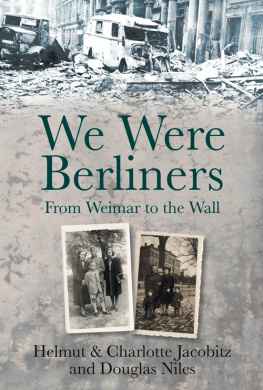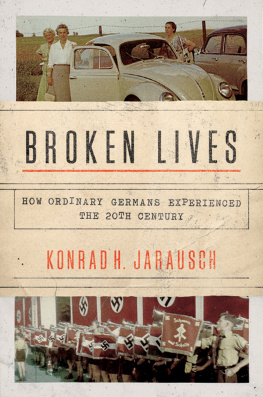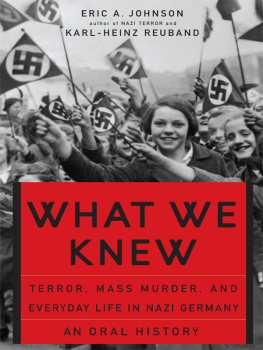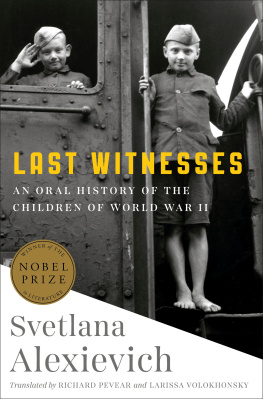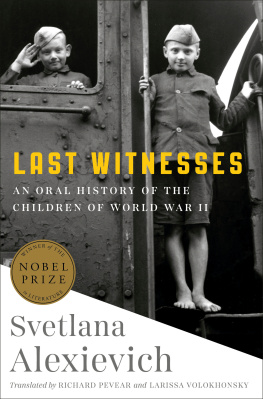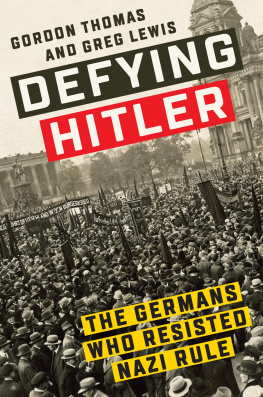Voices
of
WORLD WAR II
GENE QUIGLEY
Voices
of
WORLD WAR II
GENE QUIGLEY

 | JESPERSON PUBLISHING
100 Water Street P.O. Box 2188
St. Johns NL Canada A1C 6E6
www.jespersonpublishing.ca |
Library and Archives Canada Cataloguing in Publication
Quigley, Gene, 1964
Voices of World War Two / Gene Quigley.
ISBN 1-894377-21-4
1. World War, 1939-1945--Personal narratives, Canadian.
2. World War, 1939-1945--Veterans--Newfoundland and Labrador--Biography.
3. Soldiers--Newfoundland and Labrador--Biography. I. Title.
D768.154.N49Q84 2006 940.5481718 C2006-903979-8
2006 Gene Quigley
Editor: Annamarie Beckel
All photographs, except where noted, were provided by the men and women who were interviewed.
Front cover photographs:
Top, from left: Art White, Len Williams, Gordon Drodge, Austin Smith, Taylor French,
Angus Legrow, Hubert Thistle, and Bruce Taylor.
Bottom, from left: Eric Thomson Baggs, Jessie Windsor [Goodyear], and Thomas Joseph Houlihan
 | We acknowledge the financial support of The Canada Council
for the Arts for our publishing activities. |
We acknowledge the support of the Department of Tourism, Culture and Recreation for
our publishing activities.
A LL R IGHTS R ESERVED . No part of this publication may be reproduced, stored in a
retrieval system or transmitted, in any form or by any means, without the prior written
consent of the publisher or a licence from The Canadian Copyright Licensing Agency
(Access Copyright). For an Access Copyright licence, visit www.accesscopyright.ca
or call toll free to 1-800-893-5777.
Printed in Canada
CONTENTS
ACKNOWLEDGEMENTS
This book could not have been written without the cooperation of the men and women who patiently responded to my interviews, and I am grateful for their help, as well as for the photographs they generously provided for use in this volume. I would like to thank the late Austin Smith, who was one of the first veterans I interviewed. He was in failing health but still had time for my ceaseless inquiries regarding his campaign in Italy.
And lastly I must thank my wife Cindy for her patience and encouragement not to mention one or two good ideas.
INTRODUCTION
The foundations for this book were in progress long before I knew it. As a young boy growing up in St. Johns, I was fascinated by anything related to the Second World War, even though the war had ended almost 20 years before I was born. I went from playing with toy soldiers to reading comics about the war.
I read books about World War II and watched movies and documentaries. I found the documentaries the best, and I can still sit down and be captivated by them. Next I began cutting war-related articles out of newspapers. In 1997, I started a family history, which included relatives who had served in the war.
Most of what I read or saw about the war is from an American or British point of view, and one purpose of this project was to find out how Newfoundlanders contributed to the war effort. Most of us know someone who was in the Royal Navy or Royal Artillery, but beyond that, people know very little of what Newfoundlanders did and how important their contributions were.
For many Newfoundlanders, World War II was the defining event of their lives and their generation. Men and women volunteered for all branches of the Canadian, British, and American armed forces. Some volunteered with a sense of duty, some with a sense of adventure, many with both. There were those who even lied about their age to get into the armed forces. All acknowledge the brutality and ugliness of war, but few regret their decision to serve.
More than 60 years have passed since the end of the war, and veterans are passing away at an alarming rate. These people are walking encyclopedias, and although Herb Wells in Under the White Ensign and Comrades In Arms and Col. G.W.L. Nicholson in More Fighting Newfoundlanders have done some excellent work, very little has been done to preserve the veterans oral histories. Over the past three years I have conducted more than 60 interviews with 32 veterans. My first interview was with the late Austin Smith of Mount Pearl in February 2003. His interview just blew me away. Before the interview, I had thought that I had a little knowledge of the war, but most of the things he spoke about I had never heard before. He was a tank commander in Italy with the Canadian Army and had been involved in a lot of heavy fighting. I had a number of interviews with Mr. Smith, and I went to the library before each one so I could keep up with what he was telling me. Through him, I met a number of his friends who were also in the Canadian Army, and that is how I gathered people to interview. Of each person I went to see, I would always ask who else I should interview, which always led to more names and phone numbers.
Ive included a cross-section of people who served in the various armed forces. I regret, however, that I had the opportunity to interview only one man from the Royal Newfoundland Regiment and no one from the Royal Canadian Naval Volunteer Reserve, and I apologize to those veterans that I do not have chapters for those branches.
Because so much time has passed since the end of World War II, the possibility for errors does exist. To help ensure accuracy, the veterans who were interviewed proofread their individual narratives, but any errors are mine, and I apologize for all errors and omissions.
The majority of stories in the following pages come from Newfoundlanders or from people who have a strong Newfoundland connection, and the purpose of this book is not only to find out how Newfoundlanders contributed to the war effort, but also to keep the memories and experiences of our veterans alive. These personal histories, in the veterans own words, speak for themselves and bring history to life.
CHAPTER 1
C ANADIAN A RMY
When Great Britain declared war on Germany on September 3, 1939, Newfoundland, being a colony of Britain, was at war too, but Newfoundland did not have a military of its own. With the defeat of France in 1940, Canada saw Newfoundlands lack of a military as a threat to its safety, and Canada was forced into a closer defence relationship with Newfoundland. In June 1940 elements of the Canadian Army arrived in Newfoundland, and Newfoundlanders joined up.

In the fall of 1941, these eight young men, all close friends, went to Lesters Field in St. Johns to join the Sherbrooke Fusiliers, which was an infantry regiment of the Canadian Army. In addition to those named in the photograph, there were George Gulliver, Kevin Griffiths, and Pat Lewis. In this chapter are some of their stories.
The Sherbrooke Fusiliers served in Newfoundland from August 15, 1941, to February 19, 1942.

Left to Right: Art White,
Next page




